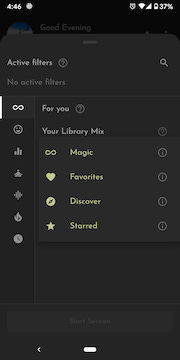Timeline
September 2019 — November 2019
But Why?
In our quest to implement vibes, we came across a very interesting realisation: people were using Lishash mostly for discovery of music, not to tackle choice overload explicitly.
Several users had asked us to provide more control over the recommendations as there were no playlists. We did not want to create another feed or playlisting system, so had to come up with a new interface that would not induce choice overload. For instance, if someone wants to explore loud electronic music, how do they do it in a playlist free system?
Now that we were not using deep learning, we had a lot of command over the recommendations from our backend, and had already created several categories of musical metadata.
Experiment
We implemented filters for implicit musical features like loudness, speechiness and happiness, and for explicit features like genres, artists, languages, and instruments. Users could also a combination of these filters.
In addition to music metadata filters, we ended up creating filters for how discovery friendly the algorithm has to be.
We had already built a database of 15M tracks with their basic metadata during our deep learning days. The main source of this data was scraping playlists across the internet, and that created a lot of noise. To overcome this noise we made the tags of track editable by the community, and built a stack overflow like system to maintain hierarchy and quality.
Observations
People started applying several combinations of the filters we created to discover music. For instance, a lot of users combined Favourite + genre filters to basically recreate their playlist experience.
Before starting their sessions with let all go, a lot of users would usually apply at least one filter.
A lot of members from the Indian indie music community joined the app after we implemented filters. Their main purpose was to uncover unknown musicians based on genres. They found Lishash to be much easier to use for this compared to established streaming services.
The genre and discovery filters were by far the most used ones, followed by speechiness.
Once we gave users the power to edit metadata, only a fraction of them used it, but used it a lot. They ended up correcting a lot of tags that improved the experience for everyone.
With filters fully implemented people who used them stopped using left swipe, and would rather just put block filters if they did not want a certain kind of music.
Our word of mouth increased significantly. Users would discover new music, share it with their friends, and talk about how they discovered on this app named Lishash.
While people found vibes really difficult to understand, the idea of filters was very intuitive for them to grasp. Still, not everyone understood the need for filters though, they would constantly show a discover weekly, or some playlist to us and say that filters and vibes are not needed in the first place.
Conclusion
Filters made our recommendation system really robust. If you wanted no control you could just use let all go mode, and if you wanted a lot of control you could use as many filters as you want. Users really liked this power.
Maintaining community generated quality metadata is a huge problem. Majority of the users don’t contribute as they find it too tedious. They also feel scared that if they do something wrong, everyone’s experience can get deteriorated. Clearly a user interface problem.







